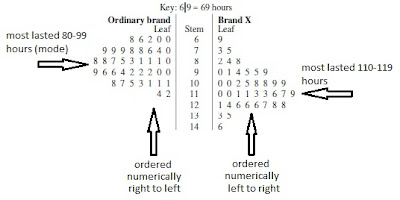This is the last section of our study of Statistics, on "Comparing sets of data". Stemplots and Boxplots are particular useful for doing this.
This lesson you need to make sure you understand:
- Back-to-back stem-and-leaf plots:
- these are used to compare the distribution of two similar sets of data, by giving a visual representation of the sets of data.
- the two sets of data share the one central stem. The set on the left are ordered numerically from right to left.
- use mode(s) and spread to compare the data sets.
For example, the following back-to-back stemplot shows how long 40 batteries of Brand X lasted, and how long 40 batteries of another "ordinary" brand lasted. We can say that: - Brand X batteries can be expected to last longer than ordinary batteries, by up to 20-30 hours.
- However Brand X lifetime a slightly more variability in battery lifetime (146-69= 77-hours, whereas Ordinary brand range from 114-60= 54-hours).
- Parallel Box-plots:
- these are also very good for comparing two sets of data, visually.
- two boxplots (one for each set of data) are drawn using the same scale. Remember, a boxplot graphs the 5-number-summary (min,Q1,median,Q3,max). Here is a picture of parallel boxplots for our batteries data:
- this visual representation is better in some ways, as you can now compare:
- medians (central tendancy),
- IQRs (spread) and
- ranges (spread)
- Looking at the above parallel boxplots we again see that:
- Brand X are expected to last longer (by 20 hours - from medians)
- Brand X shows more variablility (its range is 77 hours and IQR is about 27. Ordinary brand range is 54 and IQR is about 19)
- Since 25% of data lies between Q3 and max, we can say that more the one quarter of Brand X batteries last longer than the longest lasting Ordinary brand. Ask MrB if you can't see this from the graph.
- Parallel Box-plot on your CAS ClassPad:
Read through WE 19oon textbook page 52-53 and do it on your own ClassPad (or your laptop) to show you how to display parallel boxplots on your calculator.
You are now ready to:
- work on the 1H exercises
- read through the Chapter Summary and
- do the Chapter Review questions
ENJOY!!!!!!! MrB



